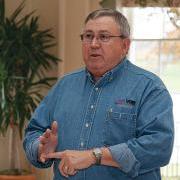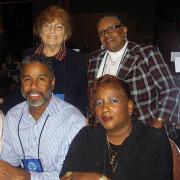|

NBC “Today” show weatherman Al Roker believes he wouldn’t be where he is today without his SUNY Oswego degree and the guidance he received from a pair of former UUPers who helped swing open doors in broadcasting for him.
“Dr. Lewis O’Donnell, he was a local broadcasting legend who played Mr. Trolley on ‘The Magic Toy Shop,’ set up my first job (interview),” Roker said during a recent phone conversation from the “Today” show set. “I was in Doc O’Donnell’s TV performance class and, at the end, he told me about a weekend weather job at (Syracuse TV station) WHEN. Soc Sampson, who was in charge of graphics at Oswego, helped me make two weather maps that I could draw on and we did tapes and sent them to the news director. I auditioned and I got the job.
“Doc always preached ‘Get your foot in the door,’ so I figured I’ll do this weather gig until a directing job opens up,” Roker continued, laughing. “I wouldn’t be at NBC today if it weren’t for SUNY Oswego. I’m very proud of that school and my SUNY education.”
Roker is in very good company. Over the years, thousands of SUNY graduates have gone on to make amazing achievements in science, medicine, business, broadcasting, journalism, entertainment and dozens of other fields.
SUNY graduates are Pulitzer Prize winners, doctors, astronauts, and war heroes. They are entrepreneurs who played roles in the development of the Apple Macintosh computer, SoBe energy drink, Jolt cola and the Internet social site, MySpace.
SUNY alumni are award-winning authors, and Grammy, Emmy, Golden Globe and Tony award winners. They are top executives at VH1, IMAX, A&E Television, Disney Cruise Lines, and the Gospel Music Channel. Two Brockport alums, Dave Trembley and Stan Van Gundy, manage the Baltimore Orioles and the Orlando Magic, respectively.
Politically, they affect change statewide, nationally and internationally. Fredonia graduate James Foley is the Ambassador-designate to the Republic of Croatia. Oswego grad Heraldo Munoz is the Chilean ambassador to the United States, while Oswego’s Marianne Myles is U.S. Ambassador to Cape Verde. And Cortland grad Ann E. Dunwoody is the U.S. Army’s first female four-star general.
“I had the opportunity to consider schools like Marist and Syracuse and I’ll tell you, it was a no-brainer for me when it came to going to Buff State,” said Tom Calderone, a 1986 Buffalo State graduate who is executive vice president and general manager of music video cable network VH1. “I was able to secure internships; I got individualized attention and hands-on experience. I mean, I was program director of the (school) radio station in my sophomore year.”
For Alex Storozynski, a 1983 New Paltz graduate who won the 1999 Pulitzer Prize for editorial writing and wrote “Peasant Prince: Thaddeus Kosciuszko and the Age of Revolution,” SUNY was where he discovered his passion for journalism.
“New Paltz certainly helped my career,” he said. “It was the first stepping stone and a huge stepping stone. It was the first place I got real bylines and the first time I got state senators mad at me for things I had written.”
Alums like Storozynski and Roker know the value of a SUNY education, which explains the disdain they have for continued state cuts to the University, which amount to more than $410 million over the last 18 months. Such cuts have resulted in fewer classes and courses for students, and spurred hiring freeze and tuition increases.
“SUNY attracts great students who will hopefully stay and achieve success in the state,” Roker said. “You look at survey after survey, and when it comes to bang for your buck, you can’t do much better than SUNY schools.”
“Proper funding of SUNY is essentially creating an economic engine for New York,” said Storozynski, president and general director of the Manhattan-based Kosciuszko Foundation. “You’re not only giving jobs to people who work at the colleges, you’re creating a talented pool of employees who will go out and get better jobs. It’s an investment that pays for itself.’
Howard Permut, president of the MTA Metro-North Railroad, credits his Binghamton University degree in geology for giving him the skills necessary to pursue his career. Permut, a 1973 Binghamton grad, was part of the original team that created Metro-North in 1983 and has been instrumental in expanding the railroad’s service area, ridership and revenue.
“I had some really good professors at Binghamton who taught me how to think and analyze problems and situations,” Permut said. “They made you think about things in a much broader context than the right answer. It gave me a good background and the tools to go on to graduate school.”
Calderone, Roker and Storozynski all benefitted from the mentoring of memorable professors and the hands-on experience they got at SUNY, both in and out of class.
Storozynski, who wanted to be a diplomat, was drawn to New Paltz by a course to study the United Nations for a semester. He changed his career choice to law and settled on journalism after former UUPer and political science professor Alan Chartock, executive publisher of the Legislative Gazette —a state government newspaper featuring stories by SUNY students—spoke about an internship with the paper in class.
“I figured that attorneys should know how to write, so I took an introduction to journalism course and Chartock came in and said ‘If you’re a serious journalist, you should do an internship at the Gazette,’” said Storozynski. “So I did the (Gazette) internship and I got bitten by the journalism bug.”
“I don’t know of other undergraduate universities that have programs like that,” he continued. “At that time, Hugh Carey was governor and I got to go to press conferences, and I got to meet Mario Cuomo. What college student gets to go to press conferences and ask questions?”
Calderone, awarded an honorary doctorate of humane letters by Buffalo State in 2008, felt the same way about his SUNY experience. Energized by UUPer Tom McCray, one of his communications professors, Calderone became program director of college radio station WBNY and turned it into an influential alternative rock outlet that was one of first in the country to air new music by U2, 10,000 Maniacs, R.E.M., and Goo Goo Dolls.
“10,000 Maniacs, they were like our house band and we’d have them play when we’d bring shows like R.E.M. to town,” said Calderone. “We had major record labels who would tell us that their artists would sell records because we played them. That’s why R.E.M. would play Buffalo four to five times a year.
“The classes I took and all the teachers there were so amazing and so connected to what was happening,” he said. “But working on the radio station and the television station was just as important.”
For Roker, his time at Oswego has proved invaluable; his SUNY education and the contacts he made at college led to his big break. Roker knows this, which is why he often returns to Oswego to speak to students. It’s also one of the reasons why he made a sizeable donation that led to the college’s student television studio being renamed in his honor in 2007.
“I believe in that school,” Roker said. “We don’t have a large football program, or the other things that engender school loyalty at other schools. At SUNY, you love your school because of your classes, your professors. It’s a summer evening on Lake Ontario, watching that sun set, or the fierceness of the winter snowstorms. It’s those things.”
On top of it all, Roker said, “These schools are economic engines that are going to fuel New York’s growth.”
— Michael Lisi
|











